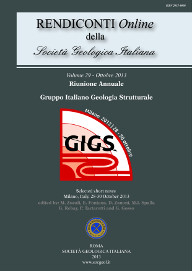
Preliminary analysis of the microearthquakes-faults association in the Sulmona basin (central Apennines, Italy)
Maria Adelaide Romano (a), Rita de Nardis (a,c), Giusy Lavecchia (a), Marco Garbin (b), Laura Peruzza (b), Enrico Priolo (b), Marco Romanelli (b) & Federica Ferrarini (a)
(a) GeosisLab, DiSPUTer, Università G. d'Annunzio, Campus Universitario di Madonna delle Piane, 66013, Chieti Scalo (CH), Italy. E-mail: aromano@inogs.it
(b) Centro Ricerche Sismologiche, Istituto Nazionale di Oceanografia e Geofisica Sperimentale, Via Treviso, 55, 33100, Udine, Italy and Borgo Grotta Gigante, 42/C, 34010, Sgonico (TS), Italy.
(c) Dipartimento della Protezione Civile, Via Vitorchiano, 2, 00189, Roma, Italy.
Volume: 29/2013
Pages: 150-153
Abstract
The Sulmona basin and the neighbouring Morrone-Porrara and Majella ridges are a sector of the central Apennines (Italy) characterized by the existence of active normal faults, to which strong historical earthquakes have been associated. At the same time, the instrumental seismicity acquired round here from the national and regional permanent networks is very low, both in number of events and in magnitude.
In order to lower the magnitude threshold of the detectable earthquakes and to obtain a more reliable picture of the microseismicity of this zone, a small temporary seismometric network was deployed around the Sulmona basin for nearly three years (from May 2009 to November 2011).
Data acquired in the first seven months of monitoring (from May to December 2009) allowed us to locate hundreds of very small earthquakes, also with negative magnitudes. The highest recorded magnitudes reached values of 3.7 and the completeness magnitude of the obtained catalogue is equal to 1.1.
The spatial distribution of the recorded microseismicity showed some local clustering, allowing us to advance preliminary observations on the geometric relationships with the outcropping active faults. Moreover, taking into account only the best located events, we were able also to provide an estimate of the seismogenic layer depth.
Keywords
Get Full Text